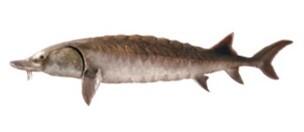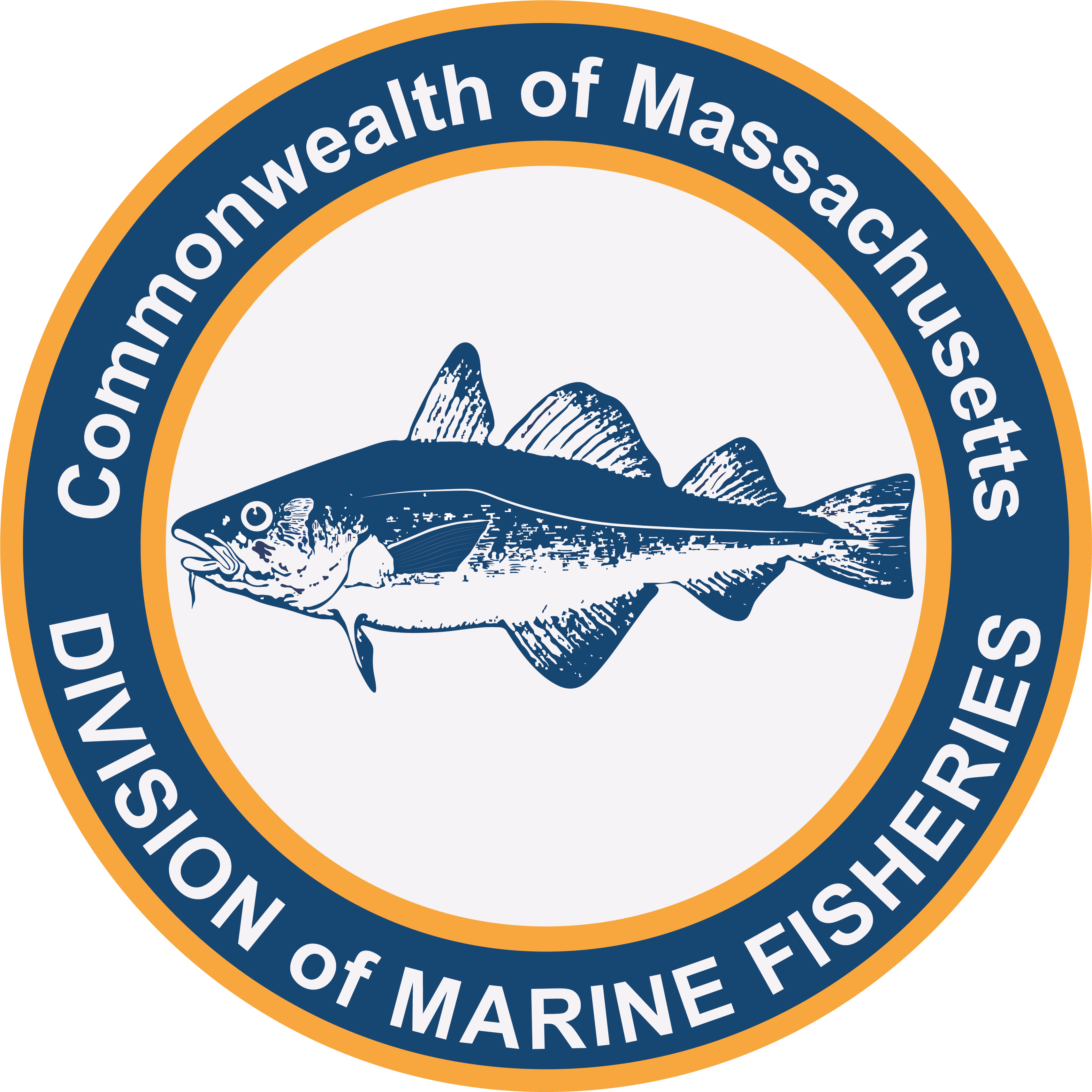- Division of Marine Fisheries
Sturgeon are ancient fish dating back at least 70 million years (with fossil records as old as 120 million years). Two species can be found along the East Coast of North America from southern Canada to northern Florida: the Atlantic sturgeon (Acipenser oxyrinchus) and the shortnose sturgeon (A. brevirostrum). While both species are distinguishable from most other fish due to their bony armor plating called scutes, Atlantic sturgeon grow much larger in size—attaining lengths in excess of 6 feet, with records of 16 feet and weighing up to 800 pounds, compared to the shortnose’s maximum length of 5 feet and weight of 60 pounds. Although both are anadromous, migrating between freshwater (to spawn) and saltwater, shortnose sturgeon spend relatively little time in the ocean, and when they do, it is generally close to shore. Because Atlantic sturgeon regularly inhabit the open ocean, they are subject to MA Division of Marine Fisheries regulation (rather than our inland counterpart, as is the case for shortnose) as well as interstate management through the Atlantic States Marine Fisheries Commission (ASMFC). Neither species may be fished, and any sturgeon incidentally caught must be immediately returned to the water. Both species are protected by the Massachusetts Endangered Species Act and the federal Endangered Species Act.
Atlantic sturgeon range between southern Canada and northern Florida. They may live up to 70 years, with females not reaching sexual maturity until somewhere between ages of 7 to 30, and males between the ages of 5 to 24. Age of maturity increases with increasing latitude with southern populations maturing faster and growing larger than those in the northern part of the range. They are iteroparous, capable of spawning multiple times throughout their lives; every 1–5 years for males and every 2–5 years for females. They return to their natal river to spawn, migrating upstream to riverine spawning areas in the spring or early summer (or later further south). The number of eggs produced by females increases with size and age ranging between 400,000 in smaller females to 8 million eggs in larger females. In the northern part of their range, females typically exit the rivers within 4 to 6 weeks after spawning whereas males may remain in the river or lower estuary until the fall. Juveniles may spend between one and six years in their natal rivers before migrating to the ocean. Tagging data indicate that Atlantic sturgeon travel widely up and down the East Coast and as far east as Iceland. In Massachusetts, Atlantic sturgeon utilize the Connecticut River and Merrimack River; historical records indicate they were also present in the Taunton River, but surveys have not confirmed their presence in recent years.
Indigenous tribes harvested sturgeon for their meat and eggs (roe) as early as 4,000 years ago, and since colonial times, Atlantic sturgeon supported important commercial fisheries in which their eggs were valued and sold as high-quality caviar. The sturgeon fishery peaked in the late 1800s, a period known as the “Black Gold Rush” in which landings exceeded 3,000 metric tons annually. However, sturgeon populations drastically declined coast-wide by the beginning of the 1900s with landings reduced to 9 metric tons by 1905 and further declined to less than 1 metric ton by 1989. Many states had closed their directed fisheries and in 1998 a complete coastwide harvest and possession moratorium was implemented under the interstate management plan through at least 2038, in order to build up 20 year classes. ASMFC stock assessments have since determined that a combination of historic overfishing, incidental catch, habitat loss largely due to dam construction, poor water quality, dredging within spawning areas, ship strikes and climate change have severely depleted their populations coastwide.
While overall levels of Atlantic sturgeon remain low, the population appears to be recovering slowly since the implementation of the coastwide moratorium and the designation and protection of critical habitats. However, in 2012, NOAA Fisheries listed Atlantic sturgeon under the Endangered Species Act (joining shortnose which had been listed decades prior); in so doing, they categorized the stock into five so-called “distinct population segments” or DPSs. The Gulf of Maine DPS was declared threatened, and the remaining DPSs—New York Bight, Chesapeake Bay, Carolina, and South Atlantic—were declared endangered. As an ESA listed species, Atlantic sturgeon are subject to a recovery plan, part of which for sturgeon is focused on reducing incidental catch in commercial fisheries. Recently, the Mid-Atlantic and New England fishery management councils adopted new measures (expected to be implemented in 2025) to reduce the incidental catch of Atlantic sturgeon in federal large-mesh gillnet fisheries targeting monkfish and spiny dogfish. A 2024 stock assessment and additional federal status review will determine if additional measures to reduce sturgeon bycatch in these fisheries is needed.
By John Sheppard, Diadromous Fish Biologist

